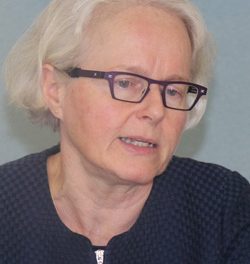
Unhealthy consumption patterns and lifestyles driving the emerging cancer epidemic in developing countries – Nangombe

The Ministry of Health and Social Services Executive Director, Ben Nangombe, said the increasing burden of non-communicable diseases (NCDs) is evident in most developing countries and underlined that Namibia is no exception.
Speaking at the occasion of the handover of funds for the 2022 Bank Windhoek Cancer Apple Project, the Executive Director revealed that cancer is one of the four major NCDs, with cervical, breast, and prostate cancers being among the top five. He added that this is a call for action, as cancer is a crucial public health issue globally and threatens the lives of many people.
“It is among NCDs which are collectively responsible for almost 70% of all deaths worldwide and has increased by 67% in Sub-Saharan Africa, between 1990 and 2017. I congratulate Bank Windhoek for running the Cancer Apple Project successfully in support of the fight against cancer,” said Nangombe. The project raised N$2 million for the Cancer Association of Namibia.
He added the Ministry of Health and Social Services (MoHSS) has collaborated with different stakeholders, and that MoHSS is committed to preventing and controlling all NCDs. “However, unhealthy consumption patterns and lifestyles are driving the emerging cancer epidemic in developing countries, which currently have more new cancer cases annually than the developed countries,” stated Nangombe.
According to him, unhealthy lifestyles like tobacco use, unhealthy diet, and physical inactivity are a factor in this epidemic.
He singled out cervical cancer as preventable and treatable. He, however, said it continues to be one of the most common cancers in women worldwide and “ranks as 2nd most frequent type of cancer among women in Namibia, and the 3rd most frequent cancer among women between 15 and 44 years of age.”
“Human Papilloma Virus (HPV) is the virus that causes cervical cancer, and other anogenital cancers, and high-risk HPV types are detected in 99% of cervical cancers. The age-standardized incidence rate for Namibia is 37.4/100,000,” he said.
Meanwhile, women living with HIV (WLHIV) are six times more at risk of developing invasive cancer when compared to HIV-negative women, he added.
In addition, Nangombe said the high HIV prevalence rate among women 15 – 49 years old in Namibia places them at increased risk of developing cervical cancer.
The World Health Organization launched the Global Strategy for Accelerated Cervical Cancer Elimination to address this public health challenge. In response to the call of the World Health Assembly, in August 2020, MoHSS started to develop the National Cervical Cancer Prevention (CECAP) Awareness and Demand Generation Strategy, a Quality Assurance Plan for Cervical Cancer Prevention services, and the National Elimination Strategy for Cervical Cancer Prevention in the journey towards elimination.
According to the ED, this is to ensure that Namibia joins the global approach to cervical cancer elimination by ensuring that 90% of girls are fully vaccinated with the HPV vaccine by the age of 15; 70% of women are screened using a high-performance test by the age of 35, and again by the age of 45; and 90% of women with pre-cancer are treated and 90% of women with invasive cancer are managed.
Nangombe said MoHSS believes that when women are healthy, families and communities are strong. “We will not rest until all women and their families—no matter where they live—can access healthcare services they need to pursue happy and productive lives.”
He also said MoHSS is therefore calling on all stakeholders to support the implementation of the Cervical Cancer Elimination Strategy with a vision that no woman should die from this completely preventable disease.”
“This battle can only be fought by a multidisciplinary team that includes MoHSS, Cancer Association of Namibia, all healthcare professionals, the media, churches, NGOs, and every Namibian citizen,” he concluded.












































